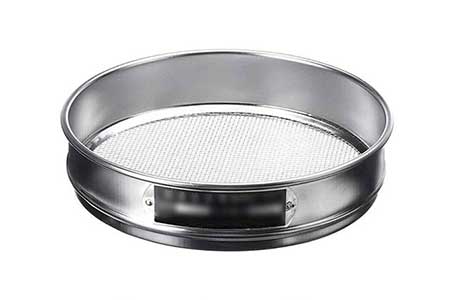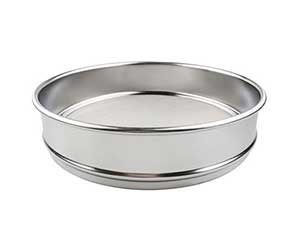Garden Sieve
Specification:
-Material: stainless steel mesh
-Shape: round
-Color: silver
-Mesh size: 1/4″
-Outer size: 16″ (40cm)
-Height: 7.5cm
Features:
-Made from good quality material, lightweight and durable for long-serving.
-Long-lasting.
-Non-Toxic.
-Stylish and elegant design, strong practicability. Economical and practical, reusable.
-Use for removing stones or debris from the soil.
-Suitable for balconies, offices, and standardized planting.
-Lightweight, easy to handle, and convenient to operate.
-Not easy to deform, fade, extended use time, safe and environmentally friendly.
-Dirt sieve Labor-saving tools, convenient, light, fast gardening, and planting.
What is a garden sieve called?
A stainless-steel strainer is a giant sieve used to separate soil, compost particles, or dirt from vegetables.
Is it reasonable to sift soil?
It removes rocks and debris like broken glass from the soil by sifting. Doing so improves the soil texture, allowing water and air to penetrate more easily. In addition, it can remove weed rhizomes-root systems that could grow new weed colonies.
What is the use of a soil sifter?
A soil stone mesh can quickly take care of your screening needs and is also a snap. Essentially, you put the gravelly soil on a screen and sort through, allowing the fine soil to sift through while the clumped material remains above for easy sorting.
You can refine the foundation of your garden by sifting your soil. Like sifting ingredients for baking, the ground filter through a screen. Large organic objects, such as rocks and broken glass, are removed from the soil during sifting. The process improves the texture of the earth, loosening it to allow for better water and air penetration. It can also remove old weed rhizomes–root systems that could grow new colonies of weeds. The benefits include improved drainage and moisture retention so that your plant’s roots are more likely to get the water they need without becoming soggy or rotting.
If you sift your soil, you can add amendments such as compost, manure, or other nutrients. By creating premium topsoil, you’ll be able to get your garden off to a great start and keep it growing strong all year long.
Do I need a garden sieve?
Using a gardening sieve will help you remove stones and weeds from your soil, making your soil much finer. Fine ground is brilliant when planting seeds, and it saves the seeds from struggling against large clumps and stones in the soil. Fine soil will help your plants grow straight and strong; for example, if a carrot hits a rock, it can become damaged and split into two. It is not necessary, but it does make life easy and improves your chances of success with the growth of your plants.
When do I sieve compost?
You should always use fine compost when potting seeds and seedlings. Sieving could be a solution if you have multipurpose compost and want to save money on something other than seed compost.
What type of sieve should I buy?
There are several types of outdoor panning soil sifter sieve on the market. Consider what you plan to use it for, your soil type, and how much space you have before buying. Your soil type and how much space you have before buying. Please take a look at our selection of sifting pans for some ideas.
Choosing the hole size for your sieve
Planting seeds requires a smaller hole since smaller holes produce finer soil. The larger the spot, the easier it will be to remove stones from your plot or garden. Garden sieves with changeable bases give you the best of both worlds.
Designs and size
It is down to personal choice. If unsure, purchase a more significant fine mesh screen classifier for the outdoor garden.















